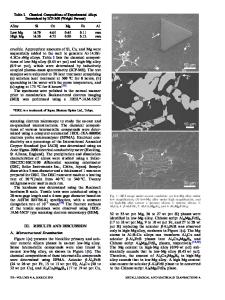Effects of minor Y addition on microstructure and mechanical properties of Mg-Nd-Zn-Zr alloy
- PDF / 1,207,829 Bytes
- 11 Pages / 584.957 x 782.986 pts Page_size
- 77 Downloads / 337 Views
ai Liu National Engineering Research Center of Light Alloy Net Forming and Key State Laboratory of Metal Matrix Composite, Shanghai Jiao Tong University, Shanghai 200240, China; and Shanghai Light Alloy Net Forming National Engineering Research Center Co., Ltd, Shanghai 201615, China
Liang Zhang, Haohao Zhang, and Wendong Cui National Engineering Research Center of Light Alloy Net Forming and State Key Laboratory of Metal Matrix Composites, Shanghai Jiao Tong University, Shanghai 200240, China (Received 19 April 2017; accepted 26 June 2017)
Microstructure and mechanical properties of Mg–0.43Nd–xY–0.08Zn–0.11Zr (x 5 0, 0.03, 0.06, and 0.12 at.%) alloys were investigated. The results indicated that Mg24Y5 phase was formed in the as-cast Y-containing alloys, the grains were refined and the amount of needle-like Mg12Nd phase in the a-Mg grain interior was increased with increasing Y addition. After solution treatment, the Mg24Y5 phase and needle-like Mg12Nd phase nearly completely dissolved into the a-Mg matrix and long-rod-like Zn2Zr3 phase occurred. The amount of Zn2Zr3 phase was increased with increasing Y content after age treatment. Mg–0.43Nd–0.12Y–0.08Zn–0.11Zr alloy exhibited the best combination of strength and elongation in all conditions, especially in the temperature range of 200–300 °C, and an Arrhenius model was established to study the plastic flow behavior. The improvement in mechanical properties was attributed to the grain refining, solution strengthening and enhanced precipitation hardening of Zn2Zr3 phase and b-type phase.
I. INTRODUCTION
Magnesium alloys are the lightest structural metallic materials and have received considerable attention for applications in aerospace and automobile industries.1–5 However, poor room temperature properties and low high temperature creep resistance and strength limit the wider uses of conventional Mg alloys. Owing to the solid solution and precipitation hardening, addition of rare earth (RE) elements such as Nd, Y, Gd is an effective way to improve the strength of Mg alloys both at room and high temperatures.6–17 Among the Mg–RE alloys, Mg–Gd and Mg–Nd system alloys are widely studied and used due to their enhanced mechanical properties. The Mg–Gd system alloys generally have a high content of heavy RE elements which significantly increase their costs and limit their application. In contrast, with low content of RE elements, Mg–Nd–Zn alloy present high strength, good ductility, and creep resistance by the formation of b0 and b9 phases.8–10 However, these alloys are not
Contributing Editor: Yang-T. Cheng a) Address all correspondence to this author. e-mail: [email protected] DOI: 10.1557/jmr.2017.277
suitable for applications above 250 °C due to the sharp drop of mechanical properties. According to many published studies, addition of Y element is an effective way to improve the mechanical properties of Mg alloys. For instance, Su et al.11 reported that with the increase of Y element, the grains of Mg–2.4Nd–0.2Zn–0.4Zr–xY (0, 2.5, 4.0, 6.0 wt%) were refined and higher v
Data Loading...











